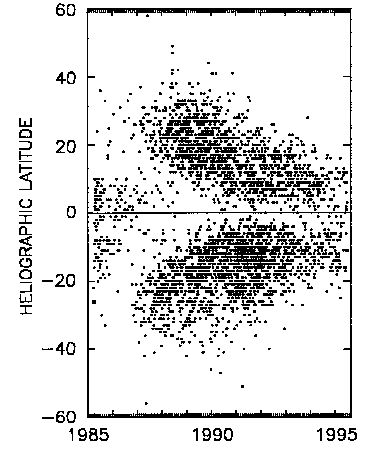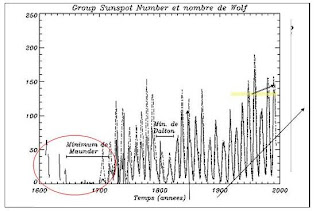I happened to read
the article “Warming On Jupiter, Mars, Pluto, Neptune's Moon & Earth Linked to Increased Solar Activity, Scientists Say “ and I would like to share how my theory on global warming relates to temperature increases on other planets..
Keep in mind it is simply a theory I have developed at this point and is simply part of the larger solar cycle.
Basically everything that the sun emits is the same. The only difference is the wavelength and frequency of the energy. Radio waves have the longest wavelength and gamma rays have the shortest.
 Sun's Spectrum of Engergy
Sun's Spectrum of Engergy We now know thanks to John Kranius that lower frequency radio waves can heat salt water, but do not affect fresh water. We can only assume at this point that the degree of salinity of the water makes it a better target for radio waves to be absorbed and result in heating. The salinity of water affects it density, the greater the density the more radio waves will affect the water.
The saltier the water the more of the sun’s radio wave energy is absorbed, the less saline the water the poorer the energy absorption.
So those solar radio waves will travel along until they are absorbed. They will simply pass through objects that do not conduct or absorb them well. That is why you can listen to a radio inside a wooden house, but radio wave reception fails inside a metal building. The metal skin of the building conducts the radio waves away and absorbs them. This is similar to why a submarine cannot use its radio while submerged. The salt water absorbs the signal.
So we know that a fair chunk of radio energy is hitting the Earth’s oceans from the sun, and the salt water is absorbing the radio waves based on their salinity, and that a byproduct of that absorption is heat. Albeit it is not very much heat for the radio waves are so long (possibly miles in length), but the radio wave energy does not just disappear.
Climate scientists will tell you solar output is rather constant and cannot affect Earth. However, if there is a movement in Earth’s ocean salinity and solar radio wave production, which relates directly to sunspots, there may be a correlation. The energy is there but Earth’s ability to store that solar radio wave energy varies based on ocean salinity.
Keep in mind that solar radio wave output has been on the rise for a number of decades… (sunspots are directly related to solar radio wave production)

In a nutshell…
Oceans at optimum salinity absorb radio wave energy from the sun and are slowly heated. When they heat, the Earth’s climate warms and the polar ice caps melt. The fresh water added to the ocean from the melting ice caps reduces the ocean’s salinity impairing the ability of solar radio waves to heat the oceans. The oceans cool and Earth’s climate cools likewise. With the cooler climate ice pack increases; water evaporates, leaving salts behind, snow falls in Polar Regions making ice pack larger and making the oceans saltier. Saltier oceans then are more efficient at absorbing radio waves and a climatic warming happens. A beautifully balanced climatic equation.
Let’s say that long slow heat cycle takes 1,500 years give or take based on solar radio wave output which can vary a bit. We know from the ice cores from Greenland there is a 1,500 year warming cycle. In addition solar radio wave output has been abnormally high for decades now. More solar radio waves, warmer oceans, warmer climate.
Strangely enough ocean scientists will tell you it takes the oceans ~1,000 to complete a mixing cycle.
.
Now keep in mind that Mars has large subterranean oceans that were recently discovered by satellites.
I would also assume that the water on Mars is also saltwater and Mars is absorbing more solar radio waves and heating just like Earth. My guess would be that all planets that are heating are gathering energy from solar radio waves based on elements within them that will absorb the solar radio wave energy efficiently.
It is so OBVIOUS! It is like all those other things in science that when you hear them laid out you wonder why it has taken so long to figure it out.
Why does solar output of radio waves vary? Think of the sun as a washing machine. You have the agitator, the drum, and the housing. The sun has more solar flares (higher radio wave output) when it goes out of balance, just like your washing machine dancing around the floor when it goes out of balance. The agitator hits the drum and the whole machine shakes.
And even though the washing machine is dancing around the floor it uses the same amount of energy and the clothes get just as clean. Similarly the sun dances around a bit producing radio waves. The overall luminosity doesn’t vary (still doing the same overall job), but it puts out more radio waves, similar to a washing machine putting out more vibrations when out of balance, but still cleaning the clothes just the same.
The suns inner core rotates at one speed, the outer layer at another, and the poles of the sun rotate at even another speed. It is easy to put that sucker out of balance.
When the sun goes out of balance the inner core bumps up against the outer layers and bingo, bango solar flares (radio waves).
What could possibly put the sun out of balance? Gravitational shear or the lack of it. Sort of like your washing machine again with too much weight on one side. The planets are all pulling on the sun in different directions. At times those gravitational shears align and pull hard simoultaneously in the same direction. Imagine you are standing in a field and four people located at north, south, and east and west toss a lasso around you and pull on their ropes. As long as they all pull equally your footing is stable. Have those four people move into the same quadrant and pull and they impart energy to you. The pulling shear becomes irresistible. Much like a pull start lawnmower.
.
Now if you want to compare how the planets pull on the sun, versus sunspot activity give this chart a gander; (Think of the blue dotted line as planetary forces and the red line sunspot activity)
I started circling the convergence but hey, what’s the point, you get the idea.

My theory, every planet in the solar system is warming based on higher output of solar radio waves and their ability to absorb that form of energy. The Earth has a climate cycle that is based on the oceans getting fresher and saltier changing their ability to absorb solar radio energy and heat them (or cool them).
I do not know of anyone else who is putting forth this theory but me, but it seems to work very nicely not only here on earth, but all the planets in our solar system.
 Some scientists believe that the sun grew larger during the Maunder Minimum (Little Ice age of 1645) and a bigger sun gave off less heat. The correct observation is that during the Maunder Minimum the sun did grow slightly in size but gave off less radio wave energy.
Some scientists believe that the sun grew larger during the Maunder Minimum (Little Ice age of 1645) and a bigger sun gave off less heat. The correct observation is that during the Maunder Minimum the sun did grow slightly in size but gave off less radio wave energy.





